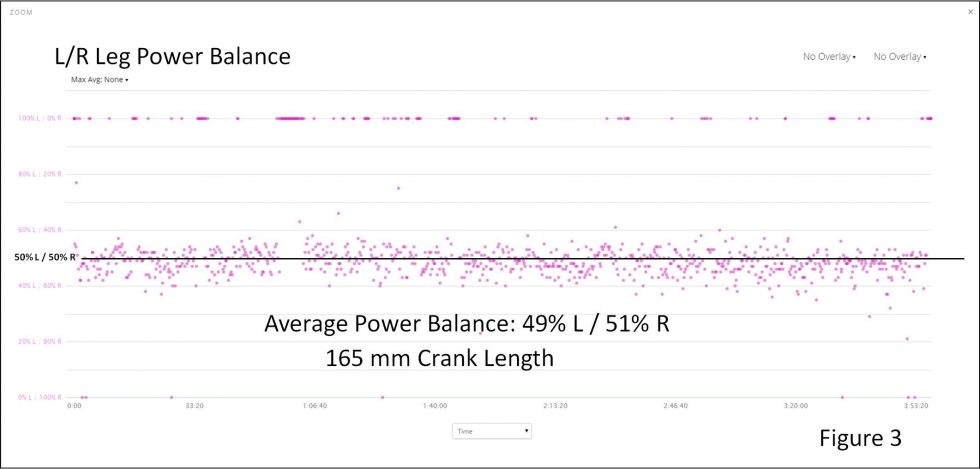Bike Fit and Garmin Power Balance
In 2015, I bought the Garmin Vector pedals. Each of the Vector pedals measure power output of the ride. I rode with the Vector pedals for several months uploading the data to Training Peaks and to Garmin Connect. One day I looked at the Garmin Connect data and the Power Balance graph. The Power Balance is a display of the percentage of the total power from the left pedal and the right pedal. To my amazement, I saw a significant right leg bias in the data. See Figure 1 (click the picture to enlarge). This graph is a left/right ratio of power from the left leg and the right leg. The data is displayed as a percentage. Data points falling below the 50%/50% line means more power is coming from the right leg. Above the 50%/50% line means more power from the left leg. Most of the data points are plotting below the 50%/50% line, meaning I’m using my right leg more than my left leg.
Figure 1
I attributed this right leg bias to having broken my left leg last year. My left leg underwent surgery to repair the break and several months of rehab and physical therapy. I figured I just needed more strength training and single leg drills on the tri bike.
At this same time, my left hip flexor (iliopsoas) had been giving me problems. My left hip flexor would become tight and fatigued on long tri bike rides. After the ride, it would remain sore for a time. I tried stretching, foam rolling, chiropractic, PT and other recovery techniques, but none of that helped. After doing some research and talking to Trent (he fit me on my tri bike) at Tri Shop we concluded that a shorter crank arm on my tri bike might help these problems.
A Bike Fit Geometry Lesson
Why would a shorter crank arm make a difference? Here is my tri bike fit geometry lesson.
During this discussion refer to Figure 2; my stick tri bike diagram. For reference, my tri bike had a 172.5 mm crank arm. That’s fairly standard on mid size tri bikes. I’ll start with dimensions A and B. Using a shorter, 165mm crank means my pedals are 7.5 mm closer to the bottom bracket (A and B). At the bottom of the pedal stroke my foot will be 7.5 mm higher and at the top of the pedal stroke my foot will be 7.5 mm lower as compared to the 172.5 mm crank.
Dimension E, which I call leg Extension, is the distance from the saddle to the center of the pedal axle at the bottom of the pedal stroke. E is defined by the athlete’s leg length and how the bike fitter sets up the athlete on the tri bike. E should remain the same even if a shorter crank arm is used.
Figure 2
Since my pedal is 7.5 mm higher (A) at the bottom of the pedal stroke when using a 165 mm crank I have to raise my saddle 7.5 mm (C) so that E remains the same.
At the top of the pedal stroke is where things get really interesting. With 165 mm cranks I had to raise my saddle 7.5 mm. At the top of the pedal stroke, my pedal is 7.5 mm lower. This means my leg extension at the top of the pedal stroke is greater (X2) with 165 mm crank arm length than with a 172.5 mm crank arm (X1). X2 is increased by 15 mm (B+C). Think about body position when in aero on a tri bike. The rider’s upper torso-hip angle can be very compressed if his knee has to come up very high at the top of the pedal stroke. Raising the saddle and lowering the pedal at the top of the pedal stroke opens up his torso-hip angle.
A more open torso-hip angle should alleviate my hip flexor pain. The longer leg extension at the top of the pedal stroke should lessen the “dead spot” as my foot comes over the top of the pedal stroke hopefully evening out my power output.
After Tri Shop installed my 165mm crank, Trent raised my saddle 7.5 mm and put me on the trainer to check my bike fit. All looked good and off I went to ride.
The Results
The results were immediate. My first ride with the 165 mm crank felt great. My hip angle felt more open. I felt more comfortable on my tri bike. I felt like I could maintain an aero position for a very long time. And, most importantly, my left hip flexor did not become fatigued and tight.
The effect of the 165 mm crank on my power balance was dramatic. See Figure 3. I have an almost perfect left leg/right leg power balance. This is much more symmetrical power output than in Figure 1.
